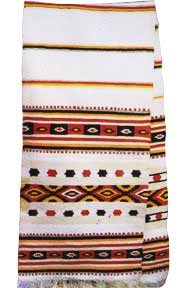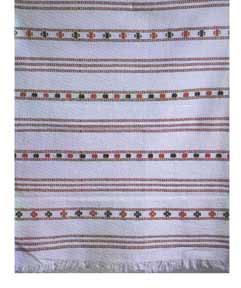S-Bands, art, software and hardware, all in one
1968 to the present; a polyvalent art space
In 1967, I found myself so fascinated by the cheerful aspect of a holiday installation, made from "shtergare" in the famous wood-carved Romanian church in Ieud, that I moved to study to study its basic structures.
Ieud (Yeah Ood) is a village in Maramuresh, Transylvania, Romania, where the church is situated. Its existence in the 16th century is mentioned in several documents. Destroyed in 1717 during the last great Tartar invasion, it was rebuilt a year later in 1718.
Shtergar (Shtairgaar) is a tentative spelling of the Romanian word that designates a richly decorated textile banner or towel. Over the centuries, it has been hand woven in the peasant households throughout the Romanian countryside, hence its narrow width and striped look. It is an artistic, spiritual and practical landmark of the great Romanian cultural legacy.
Actually, the "shtergar" represents only a small part of Romanian popular culture which includes highly sophisticated hand-made, personalized and unique art objects that express the soul of a people. It may be said that what sets Romanian folklore and folk art apart is its preference for expressing through an idea or an object an essence rather than augmenting or embellishing the surrounding environment. This is especially true of textiles, from the preparation by hand of threads to weaving on in-house looms. Until the 1920's almost everything in a peasant household was woven in-house: blankets, carpets, "shtergars," bed sheets, clothes, etc. While Romanian folk textiles are unique in Europe, this "going to the essence" style is echoed in Peruvian and Indonesian textiles, a fact that is hard to explain since these cultures were unaware of each other. In any case, in all of them, the stripe is a major player.
While reducing a shtergar to its basic structure (image at the right side ) I stumbled on what I would later call the S-Band (Sherban’s band).




S-Bands are composed of a physical structure and a digital counterpart to this physical formation. [See images]. Following is a brief presentation of the ways in which S-Bands have been explored and developed.
1. Physical Structure
The physical structure, created in 1968, is made from any suitable material but usually out of paper. This structure exists in two manifestations:
Subclasses
• Basic two dimensional
• Open Architecture
The basic S-Band is a physical modular structure that generates such algorithmic operations as rotations, translations, reflections and overlaps. The band is also designed to carry a visual message, which is typically comprised of vertical or horizontal stripes in white, red, blue and black. These stripes range in frequencies. The aesthetic choice to use a very limited palette was made early in the process, and this choice has been maintained throughout innumerable experiments with many other suitable patterns and textures.
There are four free parameters plus those of the so-called “open architecture” that define the carrier, as well as nine that define the carried stripes (more if the visual message is particularly complex). In general there are at least 13 free parameters until the design is decided. At that point, they become embedded in its structure and transform into what may be called “imprinted software and hardware” making an algorithmic machine out of the band.
The open architecture of the S-Bands extends the basic format and greatly increases the variety and amount of the produced art.
How the manipulations will proceed rests with the artist’s imagination, curiosity and inspiration; the ability to operate this device, in its physical form, is not electrical voltage but the artist’s hand, which is activated by his or her combinatorial imagination.
The design of a basic S-Band establishes a structural look that will subsequently reverberate throughout all the variations derived from it. It is like a visual DNA that establishes everything that proceeds from it.
For the artist, a working session is triggered by the curiosity and anticipation of a next visual result. Such session evolves algorithmically and similarly to a movie: each frame builds upon the previous one and adds new elements, thus becoming a new and different entity.
Each new configuration has to be aesthetically evaluated in the context of the previous ones and in anticipation of a potential one to follow.
Therefore, the operating hardware is partly its geometrical structure and partly the brain, which uses curiosity, interest, and the body as propulsive agents that drive the process from one step to the next.
The geometry is simply an idle environment that, when manipulated, forces certain types of movement but has no initiative, intuition, or opinion about how such manipulations will proceed. These rely on the artist’s combinatorial and imaginative potential.
A cybernetic relationship can also exist when the artist exchanges information with this dynamic piece of art and makes decisions according to his artistic personality. This is the principle underlying the S-Band.
• Three-Dimensional S-Bands (physical)
A band may also produce 3D spatial variations; in this instance, the changes are specifically due to the limitations in the modules’ movements which restrict the number of 2D variations. Three-dimensional S-Band configurations convey a subliminal sense of joy and a protective presence thereby forming meditative areas where people congregate.
• Banda Filamentosa
These are interesting modulations of S-Band open architecture. Banda Filamentosa is distinguished by its narrowness. The length of each band greatly exceeds the width (L>>h), resulting in bands that are very long and very thin.
2. Digital, computer assisted S-Bands
The computer-generated S-Band, created starting in 1999, is the replication of its basic geometrical attributes into an electronic format.
The process transfers and preserves the visual specifics of the converted band. When acted upon within a computer, the total number of combined artworks becomes almost endless because the physical connections among the modules are eliminated and the
S-Band can be explored as a combinatorial object.
Each physical variation that is digitized becomes the originator of a subsequent large family of electronically manipulated results, almost endless in number but united by the look and feel of the parent master.
Playing with the Birkhoff formula (aesthetic value = order / complexity) and the value of the information, the visual impact of each manipulation can be maximized.
Subclasses
• Additive Variations
Transparency is used to describe the geometric developments.
• Subtractive Variations
These variations are consequences of combinatorial experimentation.
• Boolean Color Conventions
These experiments are at the core of color composing the S-Band and focus on the interplay of adjacent colors — those of the band and those of its surroundings.
• Minimal Variations
These are a subclass of the subtractive ones and are a minimal compositional format that an S-Band can reach.
• Shifted Colors
Achieving desired palettes by shifting the continuum of numbers that represent them in digital format, which allows for attaining intended artistic expression.
• Automatically Generated S-Bands- Flash Generators
In the digital environment, the parameters that define a band lend themselves as a subject for experimenting with animation and scripting possibilities.
• Migrated Geometry, Type-N and Type-S
In this process, the continuum of numbers in a script (that defines a drawing) shifts to a new state – a cluster of migrated geometries. When rendered, these geometries transform into an unexpected, yet intimately related, fine art compositions of line, shape and color.
• Three-Dimensional S-Bands (digital)
The computer may produce very unusual geometrical entities that are logical to its processes but absurd for a real object. For instance, in the digital realm, parts of an object may appear convex and concave at the same time; similarly, such parts may float above a surface while concurrently thrusting it forward. The computer may also suggest unobtainable or unique architectural solutions.